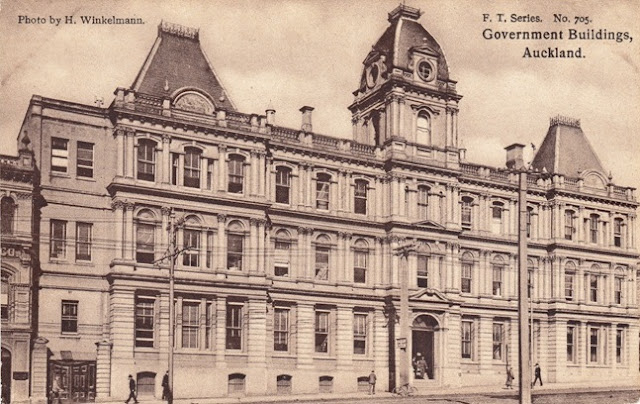June 2012 marks the centenary of the death of Sir John Logan Campbell (1817-1912). There are a number of events and commemorations happening this year -- but I wonder if they're going to all the same effect again in 2017?
Anyway, this 1906 postcard of Campbell and his statue came up for offer on TradeMe, so I thought -- why not?
On 26 August 1903, as he declared Cornwall Park open to the public, Edwin Mitchelson (then Mayor of Auckland) suggested that a statue of Sir John Logan Campbell be erected while he was still living, to perpetuate his memory as benefactor and the donor of the park. An appeal was started, supported by the Auckland Agricultural Association and the New Zealand & Australian Natives Association.
Henry Alfred Pegram took part in the 1904 tenders for the statue, offering £1180 for marble, and £1130 for bronze, including both statue and base (Star, 10 June 1904). The organising committee accepted his bronze statue price.
Sir John himself was believed to have preferred the Manukau Road entrance to the park as a preferred site, and said he would provide the statue’s base. The statue foundation base, designed by Charles Arnold, was prepared by Mr D Fallon, with a gang of workers dealing with rocks blasted from quarries, ranging from 1 to 7 tons. The height of this foundation was planned as 17 feet, with a 30 feet base. Three altar stones on top would support the rose-coloured polished Aberdeen granite pedestal, which in turn would support the statue. A water basin was constructed to surround the statue, supplied by fountains in the rockery base. Macrocarpa trees around the site were planted previously by Sir John. (Star, 27 June 1905) A number of concrete pillars were added all around the statue base.
Pegram worked on a clay model of Sir John from photos provided, and even the mayoral robes were loaned to him to work from (Star 27 June 1905).
Mr W. R. Holmes, secretary of Campbell Statue Fund, has received the following letter from the sculptor, Mr H Pegram, of London, in which he states, that the pedestal and statue were delivered to the shippers, Messrs. Westray, for shipment on the s.s. Rakaia at the end of February. He hoped the work would arrive safely. He asked Mr Holmes to convey to the committee his extreme regret for the delay in delivery, which bad caused him much trouble and annoyance.The statue was cast into bronze by the end of December, and the pedestal should have been ready by then, but the masons have been very busy, and did not keep their agreement. He had had the inscription gilded, and hoped that the committee would be pleased with the general effect. He regretted that he could not see the work placed in position."I have kept the bronze its natural colour, which will harmonise better with the red granite than the artificial green "patina," and in the beautiful climate of New Zealand, with the proximity of the sea, it will gradually develop a very fine colour such as these natural conditions will alone produce. Please convey to the committee my appreciation of the honour they have conferred on me in entrusting me with the commission."
(Star, 9 April 1906)
Auckland Weekly News, 27 June 1912, published on the death of Sir John Logan Campbell, six years after the statue was unveiled. Ref. AWNS-19120627-9-2, Sir George Grey Special Collections, Auckland Library.
It was decided that the statue should be unveiled on Empire Day, May 24.
The manager of the Auckland Electric Tramways (Mr P M Hansen) wrote offering to place at Sir John and Lady Campbell's disposal on the day of the ceremony the first electric car built in Auckland. The company would have the car suitably decorated and fitted with armchairs. It was decided to acquaint Sir John with Mr Hansen's offer and ascertain his views.
(Star 19 April 1906)
The statue arrived at Auckland and was unpacked on 30 April, and duly unveiled on its base on Empire Day. The cost of the statue came to £1360. (NZ Herald 25 May 1906)




















































